The ACVR1 R206H mutation found in fibrodysplasia ossificans progressiva increases human induced pluripotent stem cell-derived endothelial cell formation and collagen production through BMP-mediated SMAD1/5/8 signaling
- PMID: 27530160
- PMCID: PMC4988052
- DOI: 10.1186/s13287-016-0372-6
The ACVR1 R206H mutation found in fibrodysplasia ossificans progressiva increases human induced pluripotent stem cell-derived endothelial cell formation and collagen production through BMP-mediated SMAD1/5/8 signaling
Abstract
Background: The Activin A and bone morphogenetic protein (BMP) pathways are critical regulators of the immune system and of bone formation. Inappropriate activation of these pathways, as in conditions of congenital heterotopic ossification, are thought to activate an osteogenic program in endothelial cells. However, if and how this occurs in human endothelial cells remains unclear.
Methods: We used a new directed differentiation protocol to create human induced pluripotent stem cell (hiPSC)-derived endothelial cells (iECs) from patients with fibrodysplasia ossificans progressiva (FOP), a congenital disease of heterotopic ossification caused by an activating R206H mutation in the Activin A type I receptor (ACVR1). This strategy allowed the direct assay of the cell-autonomous effects of ACVR1 R206H in the endogenous locus without the use of transgenic expression. These cells were challenged with BMP or Activin A ligand, and tested for their ability to activate osteogenesis, extracellular matrix production, and differential downstream signaling in the BMP/Activin A pathways.
Results: We found that FOP iECs could form in conditions with low or absent BMP4. These conditions are not normally permissive in control cells. FOP iECs cultured in mineralization media showed increased alkaline phosphatase staining, suggesting formation of immature osteoblasts, but failed to show mature osteoblastic features. However, FOP iECs expressed more fibroblastic genes and Collagen 1/2 compared to control iECs, suggesting a mechanism for the tissue fibrosis seen in early heterotopic lesions. Finally, FOP iECs showed increased SMAD1/5/8 signaling upon BMP4 stimulation. Contrary to FOP hiPSCs, FOP iECs did not show a significant increase in SMAD1/5/8 phosphorylation upon Activin A stimulation, suggesting that the ACVR1 R206H mutation has a cell type-specific effect. In addition, we found that the expression of ACVR1 and type II receptors were different in hiPSCs and iECs, which could explain the cell type-specific SMAD signaling.
Conclusions: Our results suggest that the ACVR1 R206H mutation may not directly increase the formation of mature chondrogenic or osteogenic cells by FOP iECs. Our results also show that BMP can induce endothelial cell dysfunction, increase expression of fibrogenic matrix proteins, and cause differential downstream signaling of the ACVR1 R206H mutation. This iPSC model provides new insight into how human endothelial cells may contribute to the pathogenesis of heterotopic ossification.
Keywords: ACVR1; Activin A signaling; BMP; Fibrodysplasia ossificans progressiva; Tissue fibrosis; hiPS-derived endothelial cells.
Figures
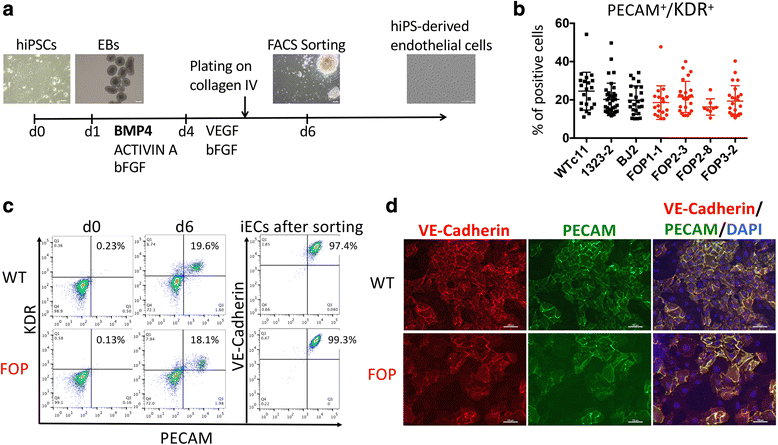
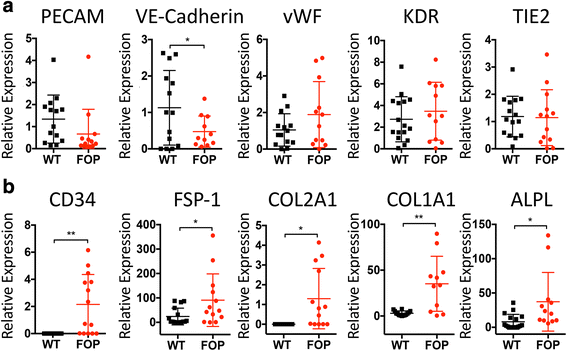
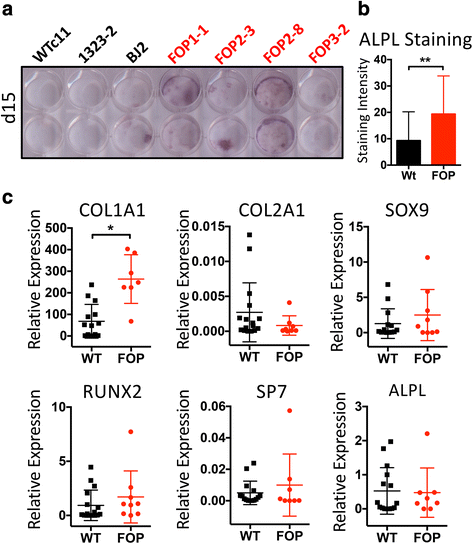
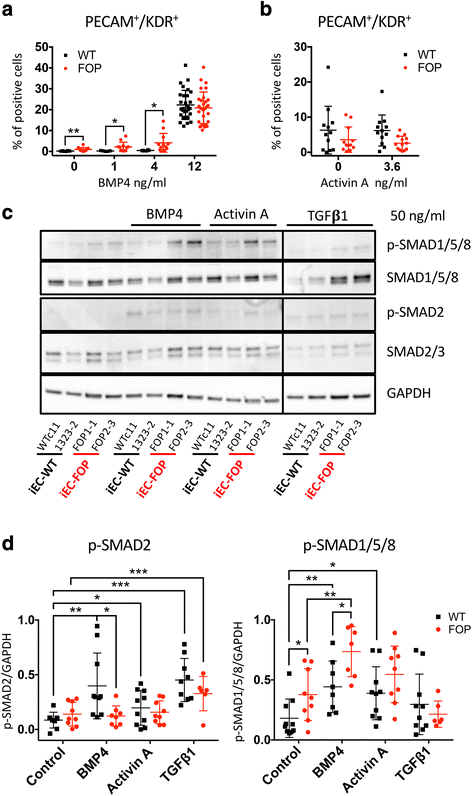
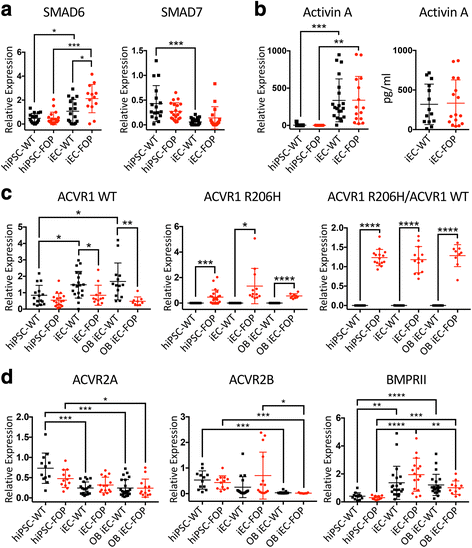
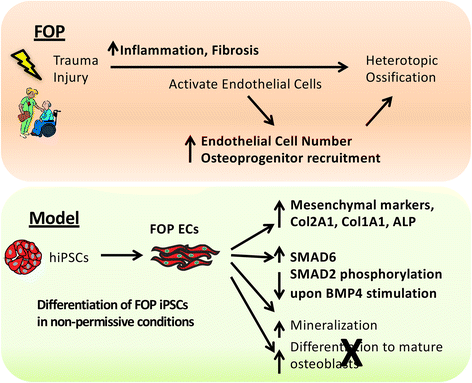
Similar articles
-
Functional Testing of Bone Morphogenetic Protein (BMP) Pathway Variants Identified on Whole-Exome Sequencing in a Patient with Delayed-Onset Fibrodysplasia Ossificans Progressiva (FOP) Using ACVR1R206H -Specific Human Cellular and Zebrafish Models.J Bone Miner Res. 2022 Nov;37(11):2058-2076. doi: 10.1002/jbmr.4711. Epub 2022 Nov 15. J Bone Miner Res. 2022. PMID: 36153796 Free PMC article.
-
Activin A amplifies dysregulated BMP signaling and induces chondro-osseous differentiation of primary connective tissue progenitor cells in patients with fibrodysplasia ossificans progressiva (FOP).Bone. 2018 Apr;109:218-224. doi: 10.1016/j.bone.2017.11.014. Epub 2017 Nov 21. Bone. 2018. PMID: 29170109
-
The Fibrodysplasia Ossificans Progressiva (FOP) mutation p.R206H in ACVR1 confers an altered ligand response.Cell Signal. 2017 Jan;29:23-30. doi: 10.1016/j.cellsig.2016.10.001. Epub 2016 Oct 4. Cell Signal. 2017. PMID: 27713089
-
The obligatory role of Activin A in the formation of heterotopic bone in Fibrodysplasia Ossificans Progressiva.Bone. 2018 Apr;109:210-217. doi: 10.1016/j.bone.2017.06.011. Epub 2017 Jun 16. Bone. 2018. PMID: 28629737 Free PMC article. Review.
-
BMP signaling and skeletal development in fibrodysplasia ossificans progressiva (FOP).Dev Dyn. 2022 Jan;251(1):164-177. doi: 10.1002/dvdy.387. Epub 2021 Jun 26. Dev Dyn. 2022. PMID: 34133058 Free PMC article. Review.
Cited by
-
Heterotopic Ossification: A Comprehensive Review.JBMR Plus. 2019 Feb 27;3(4):e10172. doi: 10.1002/jbm4.10172. eCollection 2019 Apr. JBMR Plus. 2019. PMID: 31044187 Free PMC article. Review.
-
Fibrodysplasia ossificans progressiva: Two case reports.Radiol Case Rep. 2024 May 3;19(8):2973-2977. doi: 10.1016/j.radcr.2024.04.019. eCollection 2024 Aug. Radiol Case Rep. 2024. PMID: 38737178 Free PMC article.
-
NF-κB/MAPK activation underlies ACVR1-mediated inflammation in human heterotopic ossification.JCI Insight. 2018 Nov 15;3(22):e122958. doi: 10.1172/jci.insight.122958. JCI Insight. 2018. PMID: 30429363 Free PMC article.
-
Development of Macrocycle Kinase Inhibitors for ALK2 Using Fibrodysplasia Ossificans Progressiva-Derived Endothelial Cells.JBMR Plus. 2019 Oct 7;3(11):e10230. doi: 10.1002/jbm4.10230. eCollection 2019 Nov. JBMR Plus. 2019. PMID: 31768489 Free PMC article.
-
Functional Testing of Bone Morphogenetic Protein (BMP) Pathway Variants Identified on Whole-Exome Sequencing in a Patient with Delayed-Onset Fibrodysplasia Ossificans Progressiva (FOP) Using ACVR1R206H -Specific Human Cellular and Zebrafish Models.J Bone Miner Res. 2022 Nov;37(11):2058-2076. doi: 10.1002/jbmr.4711. Epub 2022 Nov 15. J Bone Miner Res. 2022. PMID: 36153796 Free PMC article.
References
-
- Connor JM, Evans DA. Fibrodysplasia ossificans progressiva. The clinical features and natural history of 34 patients. J Bone Joint Surg Br. 1982;64:76–83. - PubMed
Publication types
MeSH terms
Substances
Grants and funding
LinkOut - more resources
Full Text Sources
Other Literature Sources

